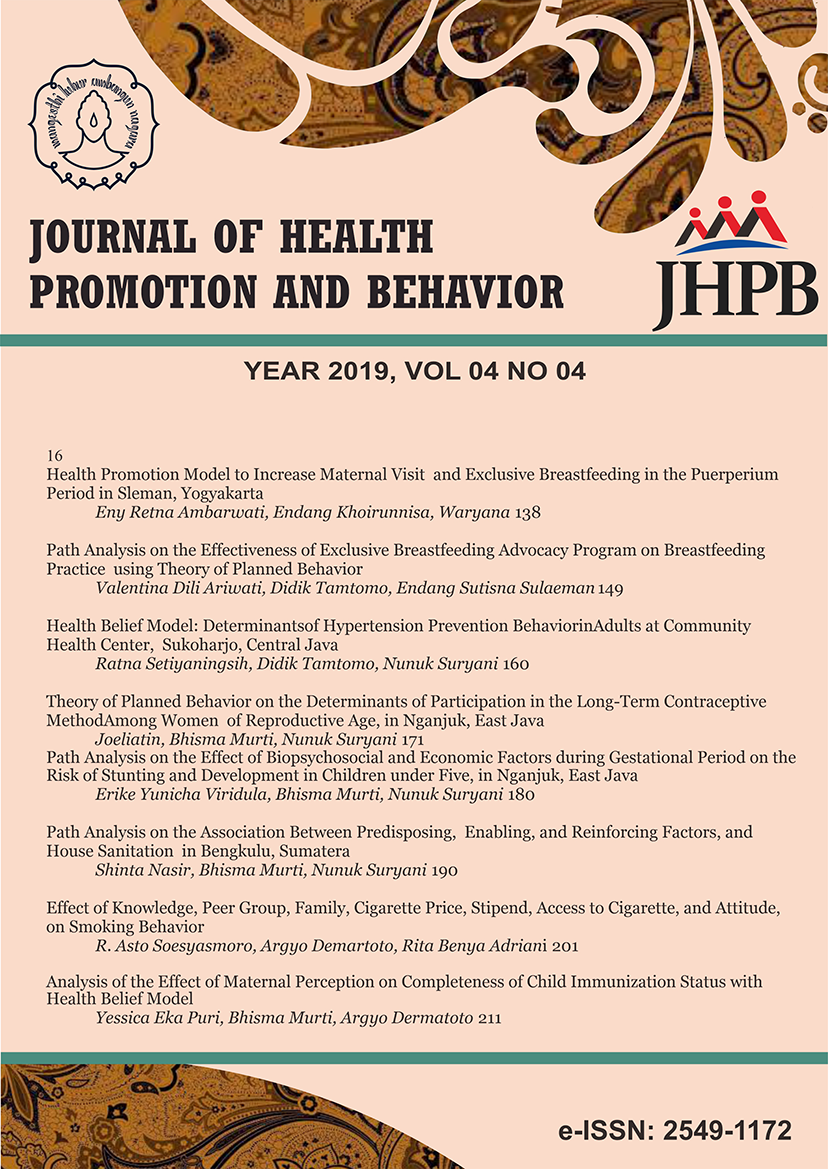Multilevel Analysis on Factors Affecting Caries Preventive Behavior among Primary School Children: Application of Health Belief Model
Abstract
Background: Dental caries (tooth decay) is a problem of children’s dental health in the world. Primary school age is a strategic group for the precaution of dental and oral diseases. There is a transition from baby teeth to permanent teeth in the early childhood. Primary school age children do not have good self-care behavior. Therefore, they need parental supervision such as maintenance of dental and oral health. The theory of Health Belief Model (HBM) is used by the community to take positive health action such as precaution of a disease. This study aimed to analyze the caries preventive behavior by using the theory of the Health Belief Model.
Subjects and Method: This study used analytic observational method with cross sectional approach. This study was conducted at 25 Primary Schools, Klaten Regency, in September 2019. This study used stratified proportional random sampling and random sampling techniques of 200 primary school children at 25 primary schools in Klaten Regency as the sampling technique. The dependent variable was caries preventive behavior. The independent variables were perceived susceptiblity, perceived severity, perceived benefit, and perceived barrier. This study used questionnaires to collect the data. The data were analyzed by using multilevel analysis on Stata 13.
Results: Caries preventive behavior increased with perceived susceptibility (b=0.89; 95%CI=0.85 to 1.69; p=0.030), perceived severity (b=1.59; 95%CI=2.73 to 0.44; p=0.006), perceived benefit (b=1.05; 95%CI=1.97 to 0.12; p=0.026), and perceived barrier (b=-1.54; 95%CI=-2.84 to 0.25; p=0.019). The variation of caries preventive behavior by 7% was determined by variables at the primary school level. This rate was smaller than the standard size of rule of thumb by 8-10%. Therefore, there was a contextual effect shown from the multilevel analysis, but the result was statistically low.
Conclusion: There is an effect of perceived susceptibility, perceived severity, perceived benefit, and perceived barrier on caries preventive behavior in primary school children. There is a contextual effect of primary school on caries preventive behavior based on the theory of Health Belief Model, but the result was statistically low.
Keywords: multilevel analysis, primary school children, theory of Health Belief Model, precaution of caries.
Correspondence:
Dewi Mustika Ratih, Masters Program in Public Health, Universitas Sebelas Maret. Jl. Ir. Sutami 36A, Surakarta 57126, Central Java. Email: dewiratih1822@gmail.com. Mobile: +625640041822
Journal of Health Promotion and Behavior (2019), 4(4): 258-266
https://doi.org/10.26911/thejhpb.2019.04.04.02
How to Cite
References
Anagnostopoulos F (2011). Self-efficacy and oral hygiene beliefs about toothbrushing in dental patients: a model-guided study. J Behav Med. 37(4). 132-9. doi: 10.1080.08964289.2011.636770
Goodarzi A (2019). Predicting oral health behaviors among Iran students by using health belief model. J Edu Health Promot. 8(10): 19. doi:10.4103/jehp.jehp_10_18
Heaton B (2018). Oral health beliefs, knowledge, and behaviors in Northern California American Indian and Alaska native mother regarding early childhood caries. J Public Health Dent. 77(4): 350-359. doi:10.1111/jhpd.12217.
Hooley M, Skouteris H, Boganin C, Satur J, Kilpatrick N (2012). Parental influence and the development of dental caries in children aged 0-6 years: a systematic review of the literature. J Dent, 4(11):873885.http://doi.org/10/1016/j.jdent.2012.07.013.
Indrian PT, Tamtomo D, Wujoso H (2014). Hubungan persepsi kerentanan dan keseriusan penyakit dengan pelayanan kesehatan pada health belief model. Universitas Sebelas Maret Surakarta. Retrieved from https://digilib.uns.ac.id/dokumen/download/36927/MTA2NDMx/Hubungan-Persepsi-Kerentanan-Penyakit-Dan-Keseriusan-Penyakit-Dengan-Pelayanan-Kesehatan-Pada-Health-Belief-Model-COVER.pdf.
Koizer, Erb, Berman, Snyder (2011). Buku ajar fundamental keperawatan: konsep, proses dan praktik (7 ed., Vol 1). Jakarta: EGC
Murti B (2018). Prinsip dan metode riset epidemiologi edisi keempat. Karanganyar: Bintang Fajar Offset.
Najarkolaei R (2016). Predictors of oral health behaviors in female students: an application of the health belief model. Iran Red Crescent Med J. 18(11):24-47. doi:10.5812/ircmj.24747.
Ningrum DNS, Murti B, Dharmawan R (2016). Path analisis hubungan pendidikan dan konstruk health belief model dengan kinerja kader pada pengendalian kasus tuberkulosis di puskesmas baki kabupaten Sukoharjo. J Health Policy and Manage. 1(1):38-43. doi: 10.26911/thejhpm.2016.01.01.06.
Puri YE, Murti B, Demartoto A (2016). Pengaruh persepsi ibu tentang imunisasi ditinjau dengan health belief model terhadap kelengkapan status imunisasi. J Health Promot and Behav. 1(3):211-222. doi: 10.26911/thejhpb.2016.01.03.08.
Putri HH, Herijuliyanti E, dan Nurjannah N (2012). Ilmu Pencegahan Penyakit Jaringan Keras dan Jaringan Pendukung Gigi. Jakarta. EGC.
Solhi MD, Shojaei Zadeh, B Seraj, S Faghih Zadeh (2017). The application of the health belief model in oral health education. Iran J of Public Health. 39(4): 114-119.doi:10.2356.23113044.
Sulaeman S (2016). Model dan teori perilaku kesehatan konsep dan aplikasi. Surakarta: UNS Press
Sutrisni (2016). Health belief model dan analisis jalur tentang faktor yang mempengaruhi kesediaan tes human immunodeficiency Virus pada ibu hamil di kota Kediri. Universitas Sebelas Maret Surakarta. Retrieved from https://eprints.uns.ac.id/29389/.
Wakhida SW, Dermatoto A (2016). Health belief model tentang faktor-faktor yang mempengaruhi penggunaan VCT pada ibu hamil di Puskesmas Kota Malang. Retrieved from http: https://digilib.uns.ac.id/dokumen/detail/55785/Health-Belief-Model-Tentang-Faktor-Faktor-yang-Mempengaruhi-Penggunaan-VCT-pada-Ibu-Hamil-di-Puskesmas-Kota-Malang.
Wigati PW (2016). Analisis jalur dengan health belief model tentang penggunaan skrining inspeksi visual asam asetat untuk detekti dini Kanker serviks pada wanita usia subur di kota kediri. Tesis. Universitas Sebelas Maret Surakarta. Retrieved from https://eprints.uns.ac.id/28793/World Health Organization (2017). Caries. Health topics. Retrieved from https://www.who.int/topics/caries/en/.




